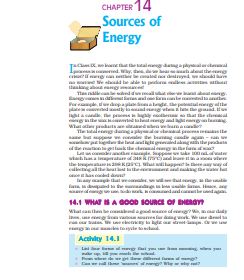‘NCERT Solutions for Class 10 Science Chapter 14‘ PDF Quick download link is given at the bottom of this article. You can see the PDF demo, size of the PDF, page numbers, and direct download Free PDF of ‘Ncert Class 10 Science Chapter 14 Exercise Solution’ using the download button.
NCERT Class 10 Science Textbook Chapter 14 With Answer PDF Free Download

Chapter 14: Sources of Energy
In Class IX, we learned that the total energy during a physical or chemical process is conserved. Why, then, do we hear so much about the energy crisis?
If energy can neither be created nor destroyed, we should have no worries! We should be able to perform endless activities without thinking about energy resources!
This riddle can be solved if we recall what else we learned about energy.
Energy comes in different forms and one form can be converted into another.
For example, if we drop a plate from a height, the potential energy of the plate is converted mostly to sound energy when it hits the ground.
If we light a candle, the process is highly exothermic so that the chemical energy in the wax is converted to heat energy and light energy on burning.
What other products are obtained when we burn a candle?
The total energy during a physical or chemical process remains the same but suppose we consider the burning candle again – can we somehow put together the heat and light generated along with the products of the reaction to get back the chemical energy in the form of wax?
Let us consider another example. Suppose we take 100 mL of water which has a temperature of 348 K (75°C) and leave it in a room where the temperature is 298 K (25°C).
What will happen? Is there any way of collecting all the heat lost to the environment and making the water hot
once it has cooled down?
In an example that we consider, we will see that energy, in the usable form, is dissipated to the surroundings in less usable forms. Hence, any source of energy we use, to do work, is consumed and cannot be used again.
14.1 What is a good source of energy?
What can then be considered a good source of energy? We, in our daily lives, use energy from various sources for doing work. We use diesel to run our trains.
We use electricity to light our street lamps. Or we use energy in our muscles to cycle to school.
The muscular energy for carrying out physical work, electrical energy for running various appliances, and chemical energy for cooking food or running a vehicle all come from some source. We need to know how to do we select the source needed for obtaining the energy in its usable form.
After going through the two activities above, we can see that the particular source of energy, or fuel, we select for performing some work depends on many different factors. For example, while selecting a fuel, we would ask ourselves the following questions.
(i) How much heat does it release on burning?
(ii) Does it produce a lot of smoke?
(iii) Is it easily available?
| Author | NCERT |
| Language | English |
| No. of Pages | 14 |
| PDF Size | 2.5 MB |
| Category | Science |
| Source/Credits | ncert.nic.in |
NCERT Solutions Class 10 Science Chapter 14 Sources of Energy
Q1. What is a good source of energy?
Solution:
A good source of energy has the following properties:
- Be economical
- Easy storage and transportation
- Easy availability
- Work done per unit volume or mass should be large.
Q2. What is a good fuel?
Solution:
Fuel is said to be good when it is easily available and when it produces a large amount of heat energy when burnt.
Q3. If you could use any source of energy for heating your food, which one would you use and why?
Solution:
For heating and cooling, natural gas can be used for the below-given reasons:
- It is easy to use
- It is easily available
- Easy transportation
- It does not produce a huge amount of smoke when burnt
- It is highly inflammable.
Questions Page: 248
Q1. What are the disadvantages of fossil fuels?
Solution:
Following are the disadvantages of fossil fuels:
- Fossil fuels like coal and petroleum results in air pollution as there is the release of a huge amount of pollutants.
- Gases such as carbon dioxide are released when fossil fuel is burnt, which causes global warming.
- Soil fertility and potable water are affected by the oxides of carbon, nitrogen, sulfur, etc. that are released from fossil fuels.
Q2. Why are we looking at alternate sources of energy?
Solution:
The reason why we are looking at alternate sources of energy is that fossil fuels are non-renewable sources of energy, i.e. they are not available in large quantities and cannot be replenished. Fossil fuels will get exhausted if their consumption is not controlled. Therefore, it is better to switch to an alternate source of energy.
Q3. How has the traditional use of wind and water energy been modified for our convenience?
Solution:
In the olden days, wind energy was trapped and used windmills to do mechanical works like lifting or drawing water from a well. But these days, windmills are used to generate electricity. The kinetic energy of wind is trapped and converted into electricity with the help of the rotatory motion of the blades, which turns the turbine of the electric generator to produce electricity.
Similarly, waterfalls were the source of potential energy in the olden days. But these days as the number of waterfalls has reduced, water dams are constructed and are used as a source to trap the potential energy. Here, the waterfalls from a certain height on the turbine produce electricity.
Sources of Energy NCERT Textbook With Solutions PDF Free Download
